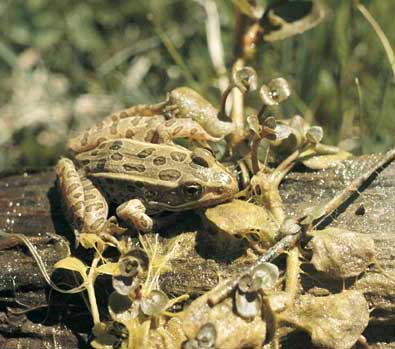|
|
|
| Subscriptions click here for 20% off! | E-Mail: info@rangemagazine.com |
|
||||||||||
|
In 1994, the year after the Mississippi River catastrophically climbed its banks in the Midwest, a region of the Chihuahuan desert along the Mexican border endured one of the harshest droughts in decades. While aid checks floated to the water-logged heartland, Arizona’s San Bernardino Valley and New Mexico’s sparsely inhabited Boot Heel were beginning to resemble a parched Dust Bowl-era landscape. But the Southwestern ranchers, whose roots to the scorched land ran deeper than the decaying patchwork of creosote and wilting grama grasses, didn’t flinch. They had long ago accepted drought as a harsh fact of life. Moreover, while trying to protect vulnerable economic interests under these harsh conditions, ranchers in the region demonstrated—and still demonstrate—a remarkable dedication to preserving a healthy, natural landscape for its nonhuman residents. That a native frog species was about to disappear from the landscape for want of water, for example, was not something that Matt and Anna Magoffin were willing to accept. Just a stone’s throw over the Arizona border, the Magoffins owned a 22,000-acre ranch but, limited by the drought, ran only a hundred head of cattle—a third of the area’s normal capacity. In addition to their meager herd, the Magoffins also hosted the last remaining endangered Chiricahua leopard frogs in the lower San Bernardino Valley. A pair of stock ponds simultaneously gave drink to cattle and habitat to frogs. “We had two populations of frogs,” said Anna Magoffin. “One had already been documented by researchers from the University of Arizona; the other had never been recorded.” One of more than two dozen leopard frog species, the Chiricahua leopard frog once ranged across mid-elevation cienegas, pools, lakes, livestock tanks, reservoirs, streams, and rivers throughout the arid Southwest. But the stocky, rough-skinned frog, currently being proposed for listing under the Endangered Species Act, has succumbed to the declining trend of amphibians that scientists believe may represent a recent and rapid plunge of an entire class of vertebrates across the globe. Habitat alteration, predation by nonnative species such as bullfrogs, and disease have all reduced numbers of the Chiricahua leopard frog, which now exists only in a few scattered remnant populations. Coupled with the severe drought that began in 1994, at least one of these few remaining natural populations could have easily slipped into the abyss were it not for the Magoffins. For two dry years, the ranchers hauled a thousand gallons of fresh water per week to ensure the survival of the frogs in one pond, while a windmill-powered pump fed water to the other pond. “We put a huge steel tank in an old, flatbed truck,” Anna recalled. “There were holes in the floorboard; the brakes barely worked. You never knew when the hood would suddenly fly up. It was always an adventure bringing water in that truck.” Subsequently, the frogs from both ponds provided tadpoles that were used to establish more frog populations at the San Bernardino National Wildlife Refuge and the Douglas High School captive propagation facility. The frogs at the high school, in fact, became a popular subject in a successful educational program for at-risk teenagers. Apparently, the Magoffins not only helped sustain a significant frog population, they inspired others to follow suit. Today, they are among many private landowners in southeastern Arizona and southwestern New Mexico that make up the Malpai Borderlands Group, a private, nonprofit organization established in 1994 to sustain traditional ranching economies in a one-million-acre region while maintaining its rich biodiversity. The group believes that strong alliances between public and private sectors, and between the ranching, conservation, and scientific communities will serve as means to achieve both goals. One such alliance under consideration is known as a Safe Harbor Agreement—a U.S. Fish & Wildlife Service program that essentially immunizes landowners from liability under the Endangered Species Act if management practices attract endangered species. The Magoffins, and many of their neighbors, are considering signing up. If participating landowners carry out agreed-upon habitat improvements, they may develop, farm, or ranch without fear of being stopped. They are only required to give the federal agency an opportunity to relocate any endangered species expected to be adversely affected. In the meantime, the long-lasting effects of drought still impose the same quashing limitations to the numbers of cattle the Magoffins can run. But the ranchers are doing an outstanding job taking care of their frogs. They now provide water for three distinct populations. Ben Ikenson works for the U.S. Fish & Wildlife Service in Albuquerque, New Mexico. |
||||||||||
|
Spring 2002 Contents To Subscribe: Please click here or call 1-800-RANGE-4-U for a special web price Copyright © 1998-2005 RANGE magazine For problems or questions regarding this site, please contact Dolphin Enterprises. last page update: 04.03.05 |
|||


